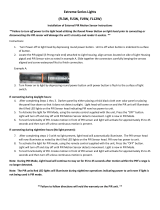
System Arming
The system has an Instant-Arm and Delay-Arm mode.
If the system is armed in Instant-Arm mode then all
detectors will immediately become fully armed. Any
detector triggered while the system is armed will
immediately sound an alarm.
Entry/Exit Delay
If the system is armed in Delay-Arm mode this will
activate the system with a 15 second entry/exit delay
period. This allows a 15 second period for the user to
exit the property after setting the system with the
Remote Control or the Remote Keypad. Any detector
triggered while the system is armed will cause an
alarm condition after the 15 second entry/exit delay
has expired. This allows time for the system to be
Disarmed before an alarm sounds when re-entering
the property.
Note: To conserve power and maximise battery life
the PIR Detector will only detect movement if there
has been no movement detected within the previous
2 minutes. Consequently the PIR Detector will not
become active until the protected area has been free
from movement for more than 2 minutes.
Alarm Lockout
If a detector is triggered while the system is armed,
the alarm will sound. After the set alarm duration has
ended, the alarm will stop and the system will
automatically reset. Subsequent detectors triggered
will again sound the alarm. If the alarm is triggered
more than 3 times then it will become ‘Locked Out’
and any further alarm signals will be ignored until the
system is re-armed.
Tamper Protection
All system devices (except the Remote Control)
incorporate Tamper protection features to protect
against unauthorised attempts to interfere with the
device.
Any attempt to remove the battery cover from any
device (except a Remote Control) or to remove the
Siren from the wall will trigger an alarm (unless the
system is in Service Mode), even if the system is
Disarmed
Jamming Detection
In order to detect any attempts to illegally jam the
radio channel used by your alarm system, a special
jamming detection function is incorporated in the
Siren. If this feature is enabled, an alarm will be
triggered if the radio channel is jammed continuously
for more than 30 seconds or if the system is jammed
f
or more than 3 periods of 10 seconds in a 5 minute
period. (The Siren will emit a series of rapid beeps
for 5 seconds as a pre-alarm warning 10 seconds
before a full alarm occurs).
The jamming detection circuit is designed to
permanently scan for jamming signals. However, it is
p
ossible that it may detect other local radio
interference operating legally or illegally on the same
frequency. If it is planned to operate the jamming
detection feature we recommend that the system is
monitored for false jamming alarms for at least 2
weeks prior to leaving the jamming detection
function permanently enabled.
Battery Monitoring
All devices powered by non-rechargeable batteries
incorporate a battery level monitoring feature which
will warn of a low battery status. The batteries on
any device indicating a low battery status should be
replaced immediately.
System House Code
In order to prevent any unauthorised attempt to
operate or disarm your system, you must configure
your system to accept radio signals only from your
own system devices. This is done by setting a series
of 8 DIP switches in all devices to the same ON/OFF
combination (the House Code) selected by the
user/installer.
The House Code is set up by moving each of the 8
DIP switches in each device to the same randomly
selected ON/OFF sequence. When setting the DIP
switches, ensure that each switch ‘clicks’ fully into
position. Use the tip of a ballpoint pen or a small
screwdriver to move each switch in turn.
All devices must be configured with the same House
Code in order for the system to operate correctly.
IMPORTANT: It is important that the system House
Code is always changed to a code other than the
factory setting and that all devices are configured
with the same House Code in order for the system to
operate correctly.
Introduction and Overview
4
e.g.
Switch 1
= set to ON
position
ON
ECE
1 2 3 4 5 6 7 8























